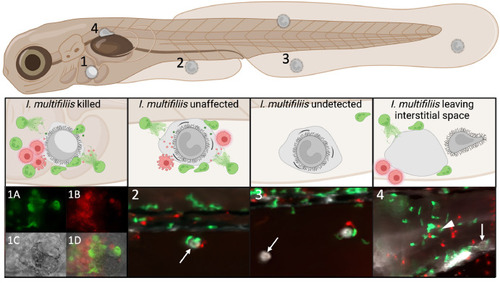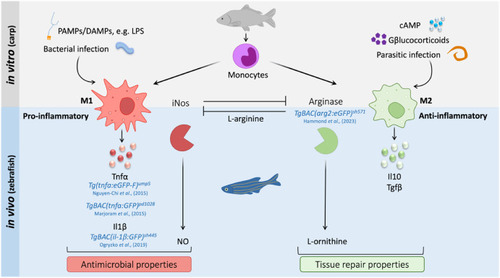- Title
-
What can we learn about fish neutrophil and macrophage response to immune challenge from studies in zebrafish
- Authors
- Speirs, Z.C., Loynes, C.A., Mathiessen, H., Elks, P.M., Renshaw, S.A., Jørgensen, L.V.G.
- Source
- Full text @ Fish Shellfish Immunol.
|
Using Pubmed the number of publications is depicted showing the result of searches with the words “fish”, “zebrafish”, “fish macrophages”, “zebrafish macrophages”, “fish neutrophils”, “zebrafish neutrophils” over the years. |
|
Summary of neutrophil and macrophage ontogeny in zebrafish. The anterior lateral plate mesoderm (blue) develops at 6 hpf, where myeloid cell precursors originate. At 20–22 hpf, the primitive wave of haematopoiesis occurs. From 24 hpf and onset of circulation, the PBI (yellow) develops, and the transient wave of haematopoiesis begins. The PBI then transitions into the CHT (orange) at 2 dpf, marking the start of the definitive wave of haematopoiesis, with HSCs differentiating into tissue-resident macrophages and mature neutrophils. From 4 dpf, the pronephric kidney marrow (pink) begins to develop, resulting in a gradual replacement of the embryonic haematopoietic system and onset of adult haematopoiesis at 7 dpf. Abbreviations: hpf, hours post-fertilisation; dpf, days post-fertilisation; PBI, posterior blood island; CHT, caudal haematopoietic tissue; HSCs, haematopoietic stem cells. |
|
Different scenarios observed in zebrafish larvae infected with the fish parasite Ichthyophthirius multifiliis. 1) Still image from a timelapse video taken with a confocal microscope from Mathiessen et al. (2023) [137]: Neutrophils (1A) and macrophages (1B) are surrounding a parasite, which just died seconds before (1C). 1D is a merge of 1A-C. Images 2–4 have been captured with a stereo microscope: 2) a parasite is surrounded by neutrophils and macrophages but was unaffected for the 5 h it was imaged (white arrow), 3) a parasite is not surrounded by phagocytes (white arrow) and 4) a parasite (white arrow) has left the interstitial space (white arrowhead) which was surrounded by neutrophils and macrophages. Green cells are neutrophils, red cells macrophages and grey cells parasites. |
|
Macrophages polarise on a continuum in response to different stimuli. Macrophages polarise towards an innate-activated pro-inflammatory phenotype following a range of stimuli, including bacterial pathogens (e.g. Mycobacterium marinum) and PAMPs/DAMPs such as LPS [234,236]. Pro-inflammatory macrophages express and release pro-inflammatory cytokines such as tumour necrosis factor-α (Tnfα) and interleukin 1-β (Il1β) [115,234]. A hallmark of pro-inflammatory macrophages is the enzyme iNos, which uses l-arginine as a substrate to produce antimicrobial NO [237]. The antimicrobial immune response of pro-inflammatory macrophages is essential for increased phagocytic activity and consequent pathogen killing. Alternatively, stimuli such as parasitic infection (e.g. Lepeophtheirus salmonis) and glucocorticoids can induce anti-inflammatory macrophages [231,232,236,238]. They express and release anti-inflammatory cytokines such as Il10 and transforming growth factor β (Tgfβ) [203,239]. The enzyme arginase is an anti-inflammatory macrophage marker, also using l-arginine as a substrate to produce ‘healing’ factors such as l-ornithine and polyamines [240]. These anti-inflammatory properties enable this macrophage activation state to promote tissue repair and return of homeostasis. References for zebrafish transgenic lines currently in use included within the figure. Abbreviations: PAMPs/DAMPs, pattern-/damage-associated molecular patterns; LPS, lipopolysaccharides; iNos, inducible nitric oxide synthase; NO, nitric oxide. Adapted from Refs. [26,241]. |




